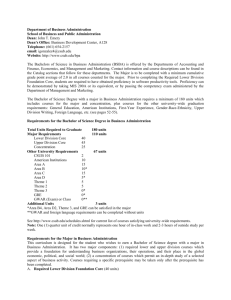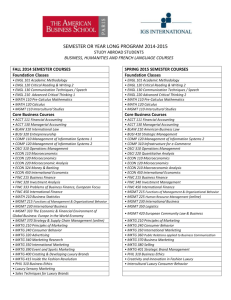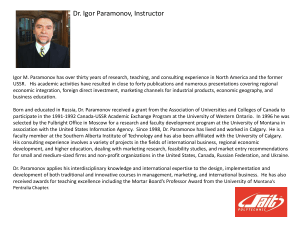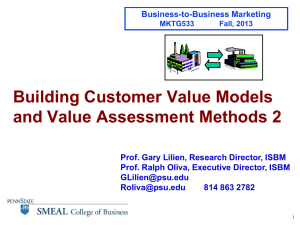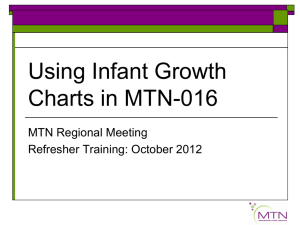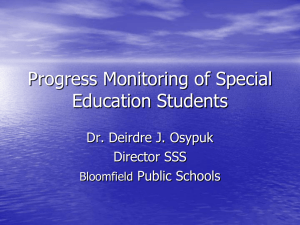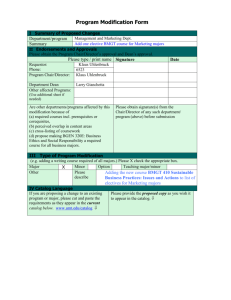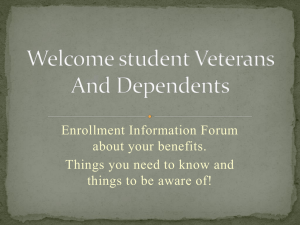An example of using data to close the loop (Debra Bryant)
advertisement
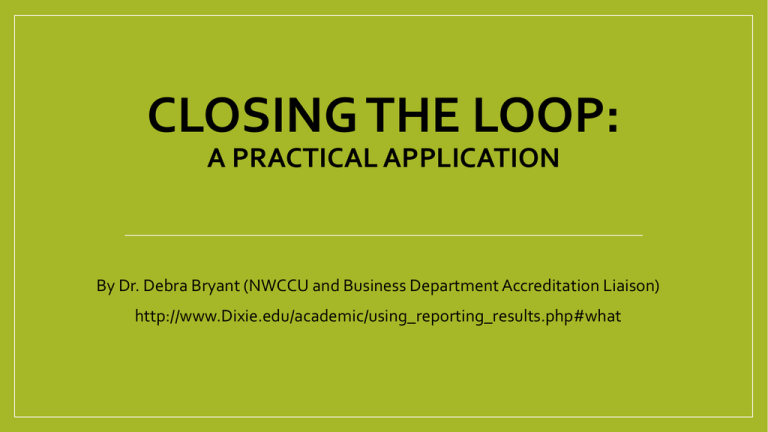
CLOSING THE LOOP: A PRACTICAL APPLICATION By Dr. Debra Bryant (NWCCU and Business Department Accreditation Liaison) http://www.Dixie.edu/academic/using_reporting_results.php#what What does it mean to “Close the Loop”? “Closing the Loop” is one of the most important stages in the assessment process. It is the action stage. Once a department has (a) decided what they want their students to learn, (b) determined where & when assessment of that learning should take place (c) gathered samples of students’ work, and (d) analyzed the data, faculty takes the time to evaluate whether students actually learned what they were expected to learn, and use that information to effectively improve teaching and learning. Faculty collaboratively: * discuss the assessment results, * reach conclusions about their meaning, * decide what changes are needed, if any, * determine the implications for those changes, and * follow through to implement the changes. An example from the Business Department (a) Decide what we want students to learn Mission The mission of the Udvar-Hazy School of Business is to prepare students for successful employment, advanced learning and service to community. We are committed to providing an environment that embraces experiential learning, stimulates academic excellence and incorporates ethical considerations. Goals 1. Provide students with core business knowledge and skills that enable attainment of advanced business degrees and success in a rapidly changing, competitive business environment. (Core Theme One – A Culture of Learning) UHSB Student Learning Outcomes 1. Students will demonstrate a working level knowledge of the core functional areas of business: A. Students will demonstrate a working level knowledge of core business functions in accounting, economics, finance, information systems, international business, legal and social environment, marketing, and management. B. Students will analyze a complex business situation, identify relevant functional business issues and suggest viable courses of action (b) Determine where & when assessment of learning should take place Direct Measurement: Major Field Test in Business by ETS When: During the Capstone course *We neglected to consider the “who” or “by whom” and the exact “when”. (c) Gather samples of students’ work Conduct Major Field Test in Business by ETS during the semester in the Testing Center. (d) Analyze the data Fall 2011 Learning Outcome for All Business Majors 1A. Students will demonstrate a working level knowledge of core business functions in accounting, economics, finance, information systems, international business, legal and social environment, marketing, and management. Assessment Method Direct: Major Field Test in Business by ETS Benchmark Timing/ Placement Not set Annually Capstone, MGMT 4800 Results Students: 40 Percentiles Overall: 37 Accounting: 61 Economics: 36 Management: 28 Quantitative: 10 Finance: 54 Marketing: 28 Legal: 30 Info Sys: 38 International: 47 (d) Analyze the data Human response to bad results? Shock! Stupid students? Bad teaching? Defensiveness In a quandary of where to start? QUESTIONS TO ASK & THINGS TO CONSIDER WHEN LOOKING AT ASSESSMENT RESULTS [adapted from “Closing the Loop” Allen & Driscoll, 2013 WASC Assessment Leadership Academy] What do the data say about your students’ mastery of subject matter, of research skills, or of writing and speaking? What do the data say about your students’ preparation for taking the next step in their careers? Are there areas where your students are outstanding? Are they consistently weak in some respects? Are graduates of your program getting good jobs, accepted into reputable graduate schools, reporting satisfaction with their undergraduate education? Do you see indications in student performance that point to weakness in any particular skills, such as research, writing, or critical thinking skills? MORE QUESTIONS TO ASK & THINGS TO CONSIDER Do you see areas where performance is okay, but not outstanding, and where you would like to it improve? Do the results live up to the expectations we set? o o Are our students meeting internal and external standards? How do our students compare to peers? Are our students doing as well as they can? Are our expectations (benchmarks) appropriate? Should expectations be changed? Does the curricula adequately address the learning outcomes? Are our teaching & curricula improving? What are the most effective tools to assess student learning? Do they clearly correspond to our program learning outcomes? Do the learning outcomes need to be clarified or revised? Possible issues to consider with assessment practices: Need revisions to the outcome. It isn’t what our students really learn. Better evidence, e.g., better assignment or writing prompt. Conclusions are of questionable validity. Better sample. It was too small or biased. The results are not generalizable. Better rubric. The criteria aren’t reasonable for our program. Calibration. Questionable reliability? Compare with something standardized. Summative or formative evidence needed? More direct assessment to actually see what our students can do. Collected too much evidence. Make assessment more manageable. Need to involve more faculty, including adjuncts. Collected only one line of evidence and don’t have confidence in our conclusion. There are many ways to close the loop. What should we do??? When results suggest the need for change, consider improvements to the program in the following areas: Pedagogy—e.g., changing course assignments; providing better formative feedback to students; use of more active learning strategies to motivate and engage students; Curriculum—e.g., adding a second required speech course; designating writing-intensive courses; changing prerequisites; resequencing courses for scaffolded learning; Student support—e.g., improving tutoring services; adding on-line, self-study materials; developing specialized support by library or writing center staff; improving advising; Faculty support—e.g., providing a writing-across-the-curriculum workshop; campus support for TAs; professional development for improving pedagogy or curricular design; Equipment/Supplies/Space—e.g., new or updated computers or software, improvements or expansions of laboratories; Budgeting and planning—e.g., reallocating funds to support improvement plans based on assessment findings; budgeting for new resources (software, staff) Management practices—e.g., establishing new procedures to ensure assessment results are tracked and used for follow-up planning and budgeting Motivation Ideas for the MAPP Test & Major Field Tests • A culture of assessment at the institution can be an immense benefit in motivating students for these types of tests. Faculty enthusiasm is a tremendous influence on students’ perception of the importance of the test. • A letter is sent to entering freshmen and it explains the importance of the test and lets them know they will be tested as a freshman and a senior. Helps to do this along with #1. • Test takers are divided into teams, with prizes and recognition awarded to the top teams, as well as top individual performers. • With Major Field Tests, some departments will award different levels of credit toward a grade in a capstone course in proportion to the score received. (One institution uses the MFT Comparative Data Guide’s average student score: if a student beats that, he/she receives a full 10% credit toward a grade, if lower, the student receives 5%). • $20 Gift certificates to the bookstore. • Free cap & gown rental..…. (d) Analyze the data (e) Close the Loop – Take action 1. Change out assessment faculty member (to nonadjunct) 2. Implement motivational activities: - Emphasize with new faculty member the importance and value of the assessment Emphasize to students the value of the assessment (resume, grad school …) School pride High score names posted Awards? 3. Set benchmarks (average at least 50th percentile in each area) (d) Analyze the data Spring 2012 LO Assessment Results 1A The percentile rank on ETS Business Major field test: Overall=88; Acct= 87; Econ= 66; Mgmt: 78; Quant:83; Fin:93; Mktg:84; Legal/Social:86; IS:88; International: 82 Much higher scores than for Fall 2011. The two lowest areas were 66rd percentile in Economics and 78th percentile in Management. Action Taken/Closing the Loop 1. Embed a grade for the ETS exam and create wall of recognition plaques for each semester cohort’s percentile ranking 2. Benchmark raised in all areas to be above the 75th percentile 3. Additional focus on & reinforcement of economics and management concept building 4. All core areas of study will gather a list of foundational concepts to be shared with all faculty (d) Analyze the data Fall 2012 & Spring 2013 Assessment Results Action Taken/Closing the Loop Fall2012 percentile rank on ETS Business Major field test: Overall=94; Acct= 87; Econ= 96; Mgmt: 96; Quant:96; Fin:88; Mktg:69; Legal/Social:99; IS:81; International: 82 Note: Mktg below 75th percentile 1. Move ETS test to week 12 of semester so that students are through most of required coursework. 2. Revise prep information from faculty. Sp. 2013 percentile rank on ETS Business Major field test: Overall=94; Acct=92; Econ=97; Mgmt:86; Quant:90; Fin:85; Mktg:79; Legal/Social:97; IS:88; International: 88. Note: Mktg still lowest, but above 75th percentile (d) Analyze data Fall 2013 & Spring 2014 Just when you think you have it right… Assessment Results Fall2013 percentile rank on new ETS Business Major Field Test: Overall=91; Acct= 84; Econ= 72; Mgmt: 66; Quant:77; Fin:71; Mktg:95; Legal/Social:98; IS:88; International: 12 Sp. 2014 percentile rank on new ETS Business Major field test: Overall=94; Acct=84; Econ=90; Mgmt:72; Quant:59; Fin:92; Mktg:84; Legal/Social:99; IS:94; International: 21 There are significant result differences, they are lower for all subject areas, except Legal/Social & IS. International Issues is of greatest concern. But, Economics, Finance, Mgmt & Quantitative Analysis are also low percentiles. Note: The newly added process of across discipline faculty involvement in test preparation was encouraging to students. (d) Analyze the data Fall 2013 Action Recommended New Business MFT with significant test revision. 1. Need to determine significance of new test results. Request copy of new revised test sample. 2. Obtain AACSB SLOs for subjects. 3. Each subject area should consider significance of lower percentile ranking. International results of particular concern. 4. Re-evaluation of International Business course content. Research AACSB SLOs for this area. 5. Assess results according to students’ majors. Quantitative Analysis results of particular concern for Bus. Admin. majors. (d) Analyze the data – Trend it Lesson: Don’t panic! Apply the right questions and considerations. # Students Overall Accounting Economics Management Quantitative Finance Marketing Legal Information Sys International Above 75 Fall 2011 40 37 61 36 28 10 54 28 30 38 47 Below 50 Spring 2012 29 88 87 66 78 83 93 84 86 88 82 Fall 2012 40 94 87 96 96 96 88 69 99 81 82 Spring 2013 37 94 92 97 86 90 85 79 97 88 88 Fall 2013 (New) 33 91 84 72 66 77 71 95 98 88 12 Note: Test revised as of Fall13 Spring 2014 54 94 84 90 72 59 92 84 99 94 21 Summer 2014 19 99 98 99 95 99 98 94 97 99 74 Don’t let assessment results dictate decisions. But, assessment results should advise faculty as they use professional judgment to make suitable decisions. Assessment results are meant to inform planning and influence decision making, therefore reporting results to the various stakeholders (e.g., students, administration, accrediting agencies, alumni) is an integral part of “closing the loop”.
